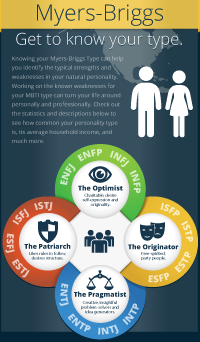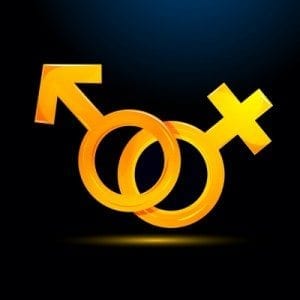Biases of all kinds can be traced back to the beginning of human existence. At its core biases are elements of natural human nature, though the awareness of biases and controlling ourselves from over indulging this human element is the future of true human nature. MBTI preferences give us a roadmap of awareness of our differences. These differences should be embraced, explored, minimizing social biases.
The beginnings of life
As parents do not always share similar personality types to their children, at times parents may disapprove of their children’s behavior. Not understanding their differences, children may be led away from developing their true self, or the personality type they were born with innately. For instance, if a child is born a Myers-Briggs® Test INFP in a family of ISTJ’s (Introverted-Sensing-Thinking-Judging Type), the ISTJ family component will most likely see the child as too “soft” or “weak” and “illogical”. According to the text “Introduction to Type Dynamics and Development”, a child or adult who’s INFP Type is not able to become sufficiently developed or reliable, “will lack a strong inner core of values that would otherwise guide their lives” (Myers & Kirby, CPP 1994). This lack of development can lead to a life of little dedication, jumping in and out of various situations that require such dedication and resolve, leaving this INFP with less meaningful personal relationships and occupational depth of significance.
Other factors that can effect and destabilize personality growth in the first half of life are cultural expectations and biases, predetermined gender roles, individual situations or state of affairs, and education.
Social Biases
The United States population is known to favor Extraversion over Introversion (Myers & Kirby, CPP 1994). This can cause problems for an Introvert in adolescents as well as adulthood. There is a correlation that exists between Introversion and Social Anxiety Disorder or avoidant behavior. Introversion is not an illness nor unhealthy, it is a preference of how certain people prefer to live their lives, though when called upon they can still manage socializing, though they do not prefer to live their lives socializing in large groups on a regular basis as part of their life schedule. Parents, teachers, and family may worry if an introverted child is not being social enough. Perhaps a child prefers to read books and spend more time to him or herself, as Introverts tend to do? Throughout U.S. history, the preference for Extraversion has singled out Introverts at a young age to be somewhat unhealthy for not spending enough time with other children or in social gatherings as teens. Parents often speak to their children about these subjects, and this can hinder the progression and development of an Introvert’s true personality type.
An example where deterred growth of an Introvert is apparent is with an individual completes a MBTI® Test and is verified as an ISTJ. If an ISTJ is pushed to be more Extroverted and therefore has developed his or her Extraversion extensively, he or she might have neglected his or her Introverted dominant Thinking Preference (this is how an ISTJ Type makes decisions, thinking through decisions in his or her head). If an ISTJ has not fully developed this ability, he or she may become too impulsive and make unwise decisions, never learning how to think through such decisions. Introverted Thinkers do not talk through problems the way Extraverts do, and no matter how favorable a society is to Extraversion, an Introvert’s decision-making process at its core does not change. Attempting to change this will only cause confusion for the Introvert.
Effect of Gender Biases On Personality Type
Many cultures across the globe have preconceived notions regarding gender differences and how a man and women are intended to feel, think, behave, and make decisions. For the most part this conceived notion is that men are supposed to exhibit the Thinking preference, or be the more logical personality type, and women are supposed to lean more towards the Feeling preference- those people that base decisions and live their lives with moral aptitude and feelings for others. When men are born with the Feeling preference, and women are born with the Thinking preference, they are usually confronted by social pressures to suppress these innate preferences, leaving them out-of-preference and in a mental state they are not naturally born to live. This can prove quite difficult for both genders in this situation, which can often lead to shame and misguided ill respect from others. While receiving this ill-respect, the human response is usually for these individuals to shy away from their natural preference of male feeling and female thinking, furthering them to forge ahead through life using their opposite less preferred ways, which can cause them confusion and unhappiness, never finding that inner peace we much desire. Modern society has made great leaps and bounds in the areas of the stereotypical male and female, gender roles and predetermined gender biases, though there is still much work to be done to accept our natural differences despite the preconceived notions of how men and women are “meant” to be and realize that both sexes are able to carry the human elements with which we are born with and should be celebrated, not dismayed.
Schooling System Biases and Personality Type
According to the text, “Introduction To Type Dynamics and Development “, elementary and primary schooling years tend to support a combination of Sensing and Judging Preferences (Myers & Kirby, CPP 1994). Remember that a Sensing Personality Type is someone who is factual, concrete, and focuses on what is real and actual, while a Judging Personality Type is someone who is scheduled, organized, and systematic. The opposite of the Sensing preference is the Intuitive preference, and the opposite of the Judging preference is the Perceiving preference. An Intuitive Type is imaginative and verbally creative, oriented to future possibilities and wants to clarify ideas and theories before putting them into practice. The Perceiving Myers-Briggs Type is spontaneous, casual, and flexible (Myers, CPP 1998).
With the schooling system for younger students being geared towards the more factual based (Sensing) and organized (Judging) Type person, what happens to the other sorts of people? The Intuitive Types are unable to use their gifts as young adults as much as they should and are often disapproved of because they are more creative and imaginative and less logical and organized in their thought process and decision-making. The end result is that the students who have innate intuition and perceiving preferences are forced to expand their uses of their sensing and judging sides before they have the chance to develop their natural strengths, which could cause issues for them later in life if they are to perform at their best personally and professionally.
In western society it is stated that once children grow and attend college and graduate school, things change. In fact, western universities and graduate schools are actually geared toward the Intuitive type unlike elementary and high schools in western culture. The university base towards Intuition can be seen in standardized timed tests and the importance of understanding theories in quick fashion. (Myers & Kirby, CPP 1994). Both of these items along with many other factors in western society make it more difficult for Sensing types to complete the majority of university and graduate studies
-
MBTI® Step II™ Interpretive Report
Price: $109.95 Buy NowDIGITAL DELIVERY
- Explore the inner workings of what makes up your MBTI® personality type
- 17-page detailed analysis indicating the complexity of your personality using five different facets
- Links to complete assessments are sent digitally via email within 2-3 business hours of purchase
- Results sent in PDF form via email within 6-8 business hours
The Result of Neglecting MBTI Personality Type Preferences
When in fact an individual’s true personality type is stifled and rejected by their surroundings several results can occur. Some individuals have been documented to over-exaggerate their born-with preferences, which can be detrimental to relationships and their work life as well. For instance, if someone is a thinking type and has been branded as somewhat critical in nature and “too logical”, they might in fact become more logical and overly critical, leading to further isolation and further rejection by others. The key to mastering your personality type is to know when and where to use your gifts. In the case of a Thinking type it would be to know when, where, and to whom to critically analyze and furthermore when this critique will be a positive input.
The rejection of one’s true self can lead to many self confidence issues, though it very rarely leads to pathology (Myers & Kirby. P.26 CPP 1994). Although it does not lead to pathology, a negative self-image can be serious enough to cause havoc in people’s lives. When there is a disparity between expectations and natural personality type and one receives continuous negative feedback that their way is not correct, individuals will begin to distrust and question themselves, causing them great pain until they re-learn and accept who they are and their natural born personality type. This individual will often feel misunderstood, isolated, and unappreciated.
If you feel that your innate type has been compromised, try to think back to when, likely in childhood, this began and who influenced you by supporting your type, and rejecting your type. Having this knowledge is an important step in returning to equilibrium and a healthy personality preference. Your next step would be to complete a Personality Assessment and discuss your results with a licensed professional. Once you have your Myers-Briggs reported type, which are your results from your personality test, then you can work on verifying your type with a professional. Verifying your type is very important and it allows you to make sure what you believe your type to be truly your natural type.
Mid & Latter Life
Once individuals enter mid-life and the second half of life, they have grown to be able to depend on their innate, natural type. It is at this point in life
that people begin to experiment and learn about what is referred to as their “less preferred functions” or those parts of your personality type that you do not use as often and are not part of your natural preferred personality type. So perhaps you might be a thinking type who throughout life you have made decisions based on pure logic, though as you age you have felt the need to begin to help others more (a feeling type trait). As a middle aged to older adult, you would have begun to understand and delve into your less preferred feeling function.
This is a very normal occurrence for thinking types as they age. In fact, the transition to mid life and latter life can be difficult for many people and this is when personality growth is important. Completeness of one’s type is important to feel whole in the latter stages of life. Utilizing your strengths in the first half of life is vital, though things do change as you age. You yearn for more learning and change. You might be faced with challenges in this stage of life you had not in your earlier years. These challenges might include losing a loved one to divorce or death, or perhaps unemployment. In order to deal with such traumas, reaching towards growth is of the utmost importance, and at times, though less then your natural preferences, using your opposite MBTI functions are important. Carl Jung believed that the rules that were appropriate for the first half of life are not necessarily appropriate for the second half of life (Myers & Kirby. P.31 CPP 1994).
Some people who have a difficult time conforming to change in the second half of their lives might be doing so because they themselves carry a stigma against people who are of their less preferred functions. They judge others who different from themselves and in turn have a difficult time developing these functions that they have seen in a negative light for most of their lives. For example, sensing types might see intuitive types as unreliable and untrustworthy, mistaking the gifts of an intuitive for their misconception and overcritical judgment. By doing so, they lock themselves into their dominant type throughout life, never allowing themselves to venture into parts of themselves they might have otherwise, stunting their growth and most likely their happiness as they age. Below is a chart that explains how certain types of natural behavior can become rigid and dislodged in later life if other functions are not developed. This chart is based on information from the text, “Introduction To Type Dynamics and Development”, and explains what can occur if development stops at midlife and people become rigid as a result:
| An Introverted Sensing Type carefully stores accurate, realistic information | Can then become rigid and → | Become overly reliant on one’s own experience as the sole source of facts worth knowing |
| An Extroverted Sensing Type delights in experiencing the variety of the world | Can then become rigid → | Become in an all-consuming search for novel experiences |
| An Introverted Intuitive Type is clear, complex insight | Can then become rigid and → | Become stubborn, blind insistent on the correctness and sufficiency of one’s internal vision |
| An Extroverted Intuitive Type has enthusiastic insight into possibilities and options | Can then become rigid and → | Become obsessive and irresponsible in the pursuit of new ideas, new people, and new possibilities |
| An Introverted Thinking Type is persistent and efficient in organizing internal logic | Can then become rigid and → | Have an obsessive drive to make everything in the world fit into a logical internal structure |
| An Extroverted Thinking Type is decisive and organizes logic of the external world | Can then become rigid and → | Have an obsessive, intensive, aggressive domination of others |
| An Introverted Feeling Type act with sensitive evaluation of oneself and others in terms of clear inner values and commitments | Can then become rigid and → | Have a judgmental insistence that only one’s own values are valid and that all other’s values are immoral |
| An Extroverted Feeling Type wants to create harmony in the world by appreciating and supporting others | Can then become rigid and → | Have an intrusive insistence that everyone be nice and happy; that there are no bad things or people |
Developing your MBTI Type can be both unconscious and conscious. Carl Jung, the psychologist of which The Myers Briggs Type Indicator® is based, believed that we are born with our personality as a whole, and as we develop our Type, we begin to differentiate ourselves. In fact he referred to the development process as “differentiation”. It is the dominant functions, or the part of your personality you are born to use most naturally that is usually the most conscious or differentiated.
It is important to remember that Psychological Type is not the only part of oneself to take into consideration when understanding and explaining behavior. There are many other factors that coincide with human behavior. Some other factors include motivation, life experiences, the degree of one’s vulnerability, physical health, and personal ethics (Myers & Kirby P.33 CPP 1994). Developing your MBTI Personality Type is important as is developing yourself physically and personally. To a certain extent, we all must conform to the outer world, and at times go outside of our preferences of behavior. Though at times uncomfortable, challenging ourselves to adapt and reach slightly towards areas of ourselves we have not yet discovered is a natural progression of life. If we grow slowly and steadily in mid-life, personal and professional success can be ours. Completing a Career or Personality Assessment, more specifically a Myers-Briggs Test is a great step forward toward your journey to understanding yourself and the world around you.
As a global society we must learn as much as we can about our differences and realize that no one person is alone in personality, preference nor the way we live our lives as no one person is like everyone else. It is this mindful visualization of facts that will keep modern society from judging one another, stifling positive growth, and perhaps in turn one day ending the violence that still plagues our world. It is the lack of acceptance that continues violence and demolition of modern society. With such great feats in social science, the one great barrier that keeps us from living in peace is the inability to accept our differences. The Myers-Briggs Type Indicator has helped millions of people understand themselves and their differences with others. Isabel Briggs Myers and Katherine Cook Briggs had a vision for the world- to understand who we are and be different from one another, and most importantly that this is okay. Dare to be different, accept these differences, and live in harmony.
References:
Introduction to Type and Dynamics (Myers & Kirby, CPP, 1994.)




